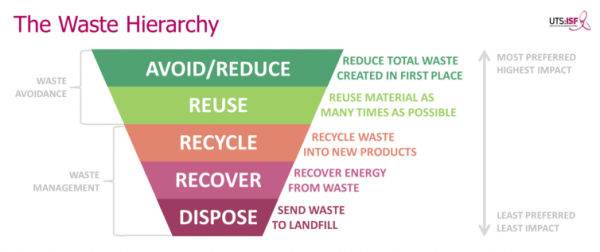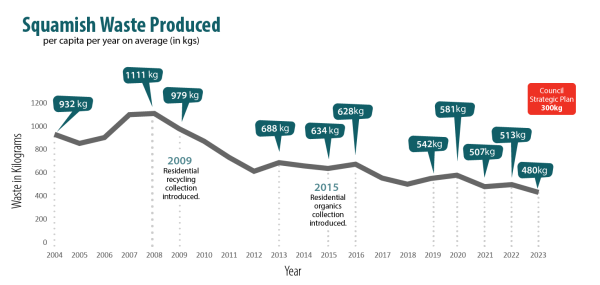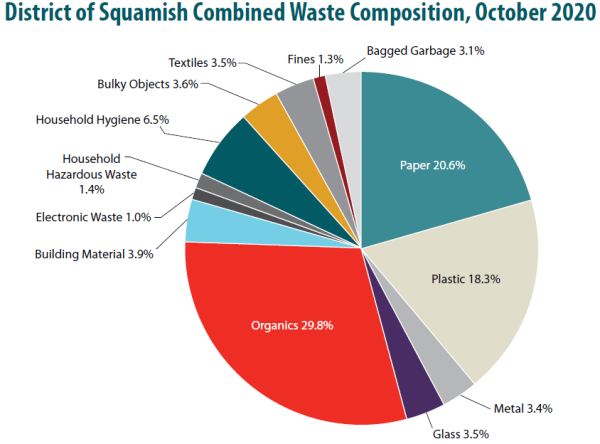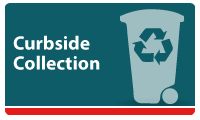Zero Waste
The District of Squamish aims to decrease the diversion of waste from landfill to 80%, and reduce per capita landfill waste to 300 kg.
View the District's Zero Waste Strategy.
Squamish has many waste diversion options for residents, including multiple drop-off locations for recycling and organics, residential recycling and organics collection for all single-family and townhouses, a free paint recycling location, a drop off for reusable construction materials at Squamish ReBuild, several extremely active non-governmental volunteer-based groups and more.
How you can help us get there:
- Reduce your use of single-use items. Practice the habit of bringing your own bag, cup, straw or other commonly used item to reduce waste in our community.
- Compost. Composting food scraps, paper towels, dryer lint, coffee filters and other organic materials is the single most effective way to reduce your garbage waste. If you are unsure as to what materials can go in your organics tote, enter the item in our Waste Wizard lookup tool to find out where to recycle or dispose of it.
- Recycle. Cardboard, mixed paper, plastic containers, and metal such as tin and aluminum cans can all be recycled in the curbside recycling program. Styrofoam and plastic bags, overwrap/film and any glass that cannot be returned for a refund can be dropped off at the GFL Recycling Depot or the Squamish Landfill.
- Consider purchasing items with zero or pure packaging. Buy bulk when possible and look for “pure” packaging products such as glass.
- Set up recycling and compost containers in a convenient place. Keep bins for recycling, organics, glass, bottles and cans where you are likely to use it most, and consider setting up small containers in other rooms of your home, such as the washroom.
- Buy Secondhand. Previously loved goods are an excellent way to cut down on cost and packaging.
- DIY (Do It Yourself). You can make a surprising number of things yourself (and save some serious cash at the same time). From bread to clothing to laundry soap, for recipes check out the Queen of Green website in the Resource section below.
- Get Educated. Read about recycling and going waste-free to learn about what others are doing. Watch The Story of Stuff (video link below), an eye opening animated, short film about the cycle of waste and consumerism. There is a lot of information out there that can help you reduce your garbage.
- Let businesses know how you feel. Writing a letter or calling a company goes a long way.

The ‘waste hierarchy’ prioritizes actions by those with the greatest environmental benefit.
Credit: UTS: Institute for Sustainable Futures
Waste By the Numbers:
- 480 kg - the average of garbage disposed of per person in the District of Squamish in 2023.
- 350 kg - the target set by BC's Ministry of Environment of garbage disposed of per person per year by 2020.
- 505 kg - the provincial average of garbage disposed of per person in 2018.
- 525 kg - the average of garbage disposed of per person in the Squamish Lillooet Regional District in 2012.


In August 2020, the District of Squamish conducted a waste audit of what is being thrown in the garbage. The above chart represents the breakdown of the overall findings. The full report is available here.
Some of the key findings from the Waste Composition Report -
- From Curbside Residential Collection, over 30% of the garbage is compostable. More than 10% of the garbage is avoidable Food Waste.
- Compostable Paper and Avoidable Food Waste are the 2 largest categories of material in Commercial Waste. They represent over 30% of the material in the garbage.
- 21% of the material in Multi-Family Garbage could be recycled at a Drop Off Depot, and 31% could be composted.
- Over 40% of the waste from the Construction and Demolition sector is Wood.
For some tips on how to reduce food waste, check out the Food Waste page. The Waste Diversion page has information on What Goes Where, and how to reduce your waste. If you are interested in learning more about the Zero Waste Strategy, please contact the District's Sustainability Coordinator.
Resources
- The Story of Stuff
- Food Hacks (Love Food Hate Waste)
- Remove your name and address from advertising mailing lists
- Stop Trashing the Climate (report)
- Queen of Green (David Suzuki Foundation)
- Waste Composition Report 2018
- Waste Composition Report 2020
- Waste Reduction in Schools
- Waste Reduction for Businesses
- Waste Audit Tool
- Zero Waste Events Guide
Waste Reduction
You Can Live Without Producing Trash
http://www.youtube.com/watch?v=nYDQcBQUDpw
Archive

Post your comment
Comments
Lilllian May 12, 2022, 12:07 PM (2 years ago)
I only have one compost at my house, but I don't know where to find anymore! I also appreciate the work the district has been doing to keep this place clean. Ty for the good job :)
Communications May 16, 2022, 2:33 PM (2 years ago)
Hi Lillian. Our Zero Waste team may be able to help with your question. Please send an email to [email protected] . Thanks!
Rachel Apr 23, 2021, 6:32 AM (3 years ago)
I appreciate everything that the DoS is doing to reduce waste and to encourage recycling. One thing that would help me is better access to recycling facilities, for items that can't go in blue bin would really help - in particular bins for 'other flexible plastic packaging'. These can only be dropped off at the GFL depot 7AM-3PM on work-days (not doable) and one day on the weekend (huge line-up). Increased hours at GFL, including being open both Saturday and Sunday, and/or a bin at the landfill recycling area (which is already open until 6PM, 7 days a week) would really help.
Thanks for considering.
Bill Cavanagh Nov 15, 2020, 10:06 AM (4 years ago)
Is it possible to obtain a copy of the Consultants report around "garbage" from a few years ago???
Bill Cavanagh Nov 15, 2020, 10:05 AM (4 years ago)
After seeing the article in the Chief "Skip the Guilt and Help the Planet" what ever happened to the clear plastic bag mandate of February 1, 2018? The picture also indicates a large amount of plastic containers that should be recycled, what happened about that?????
No one has commented on this page yet.
RSS feed for comments on this page | RSS feed for all comments